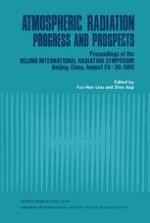1987 | OriginalPaper | Buchkapitel
Atmospheric Turbidity Monitoring by use of a Scanning Radiometer
verfasst von : M. Tanaka, T. Nakajima, M. Shiobara, T. Hayasaka
Erschienen in: Atmospheric Radiation
Verlag: American Meteorological Society
Enthalten in: Professional Book Archive
Aktivieren Sie unsere intelligente Suche, um passende Fachinhalte oder Patente zu finden.
Wählen Sie Textabschnitte aus um mit Künstlicher Intelligenz passenden Patente zu finden. powered by
Markieren Sie Textabschnitte, um KI-gestützt weitere passende Inhalte zu finden. powered by
The atmospheric turbidity was monitored by a 5-channel scanning radiometer (aureolemeter) for the period of September 1981–May 1985 in the suburbs of Sendai, Japan, The aureolemeter was designed to be able to measure both direct-solar and circumsolar radiation simultaneously, and was calibrated by a newly developed algorithm, which is far more accurate than the usual Langley-plot method. The measured intensity of circumsolar radiation was reduced to the single scattering phase function after subtraction of multiply scattered radiation. The obtained values of the phase function at a scattering angle of 20° were linearly correlated with the aerosol optical thickness and, thus, provided good indices of the atmospheric turbidity. Temporal variations of the aerosol optical thickness and the volume spectrum were retrieved from the spectral extinction and aureole data. An enhancement of monomodal aerosols, with a mode radius of about 0.5 μm and due to the El Chichon eruption, was distinguished from typical bimodal spectra of background aerosols for the period from the autumn of 1982 to the spring of 1984.
